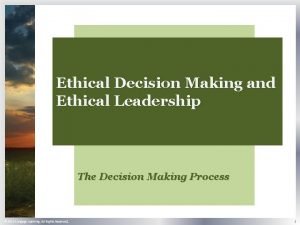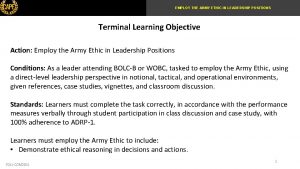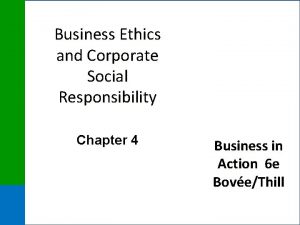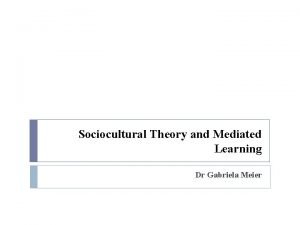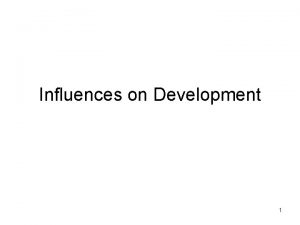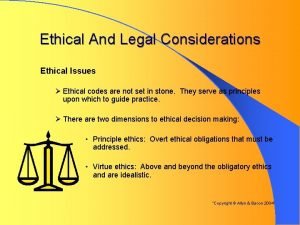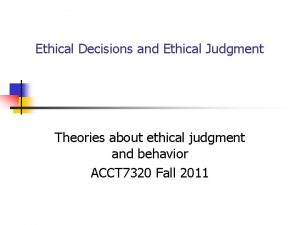Sociocultural influences 2 1 c Ethical and sociocultural


























- Slides: 26

Socio-cultural influences

2. 1. c. Ethical and socio-cultural issues in physical activity and sport Ethics in sport BY THE END OF THIS TOPIC YOU SHOULD … • know and understand LEARNING OUTCOMES • the value of sportsmanship • the reasons for gamesmanship and deviance in sport. • be able to apply practical examples to these concepts.

Sportsmanship ……………. …. involves behaviour that shows fair play, respect for opponents and gracious behaviour, whether winning or losing. Showing good sportsmanship means sticking to the rules and regulations. Sportsmanship shows that you can lose gracefully and win with good humour. Each sport has its own code of behaviour and ‘sportsmanship gestures’. Task: how many different displays of sportsmanship, fairness or etiquette can you think of?

Sportsmanship Examples of sportsmanship may include: • shake hands with your opponent • thank anyone who has been participating with you or against you • show concern for others, especially when they are injured or under stress • never swear or be abusive • • do not stretch the rules to take advantage of someone else take defeat well and show good humour do not question officials – accept their decisions say ‘well done’ to opponents when they do well • taking other people into consideration when participating in exercise – for example, swimming and avoiding colliding with other do not over-celebrate when you do well – take other people’s feelings into account and avoid arrogance in victory do not deride the efforts of others – be respectful of others, whatever their ability. • •

Etiquette Examples of good etiquette may include: • • • take other people into consideration when participating in exercise – for example swimming and putting away equipment after you use it not spitting on opponents avoid colliding with others drying/wiping fitness equipment after use and not leaving pools of sweat on machines putting free weights away replacing divots on golf courses shouting ‘fore’ when you mishit a shot in golf and it is travelling towards other players not using your mobile phone whilst playing golf raking the sand in golf bunkers after you play a shot from them applaud the new batsman in cricket.

Gamesmanship - is the use of unethical, although not illegal, methods to win or gain a serious advantage in a game or sport by ‘bending’ the rules Examples: • sledging to distract batters in cricket • not walking in cricket • coughing or stamping feet to distract shooter at free throws in basketball • grunting in tennis in order to intimidate opponents • distracting penalty takers in football (goalkeepers) • holding to prevent opponents punching in boxing • diving in the 18 yard area to gain a penalty and opponent a ‘yellow card in football • standing over the ball to gain defenders organisation time at free kicks in football • tying your laces to delay receiving a serve (to waste time) in tennis • talking to distract your golf opponent when he/she is taking a shot. Task: Can you think of any other examples of gamesmanship within sport?

Deviance - involves human behaviour that is against your society’s norms and values. Behaviour of this kind is often against the rules/laws of the game Reasons for deviance may include: • the pressure/expectation to win or to gain an (unfair) advantage or pressure from fans/spectators/parents/coaches/team mates • to enhance performance, like bowling with a slightly bend arm to bowl faster • because you are losing • to gain financial reward if you win • a reaction to (poor) decisions by officials • as retaliation/revenge on an opponent who has fouled/injured you earlier in the game • copying others, who may have got away with it earlier in the match or in a previous match • as a result of taking drugs.

Sportsmanship - can be promoted and increased through: • introducing fair play schemes and campaigns • highlighting positive role models • better quality officials and use of technology • development of positive values early on in childhood • punishment for negative behaviour • stricter code of conduct for players, spectators and clubs.

Sportsmanship or Gamesmanship? Task: In pairs decide what is Sportsmanship (S) or Gamesmanship (G) from the list below (the first one has been done for you) 1. Apologising to an opponent after the ball hits the net and drops over to win the point in tennis 2. Pretending to be injured at the end of a game to waste some time 3. Shaking hands before and after playing sport 4. Taking an injury break in tennis when you aren’t actually injured 5. Showing concern for others when they are injured 6. Kicking the ball a long distance out of play so it takes longer to retrieve to waste time and allow players to recover 7. Let faster players play through in golf if you are holding them up 8. Appealing for a throw-in even if you know it touched you last 9. Accepting all officials decision without arguing 10. Insulting opponents before they take a shot in cricket to put them off 11. Pulling on an opponent’s shirt when the referee can’t see you 12. Accept defeat and show good humour S

Sportsmanship or Gamesmanship? Task continued: In pairs decide what is Sportsmanship (S) or Gamesmanship (G) from the list below 13. Deliberate contact in netball when someone is catching a ball 14. Taking longer than usual to serve in table tennis 15. Coughing whilst someone is playing a shot in golf 16. Congratulating another athlete after he has won a 1500 m race that you ran in 17. Blocking people when running in the 10, 000 m race causing them to lose speed

Effects of Gamesmanship and Sportsmanship Task: Complete the following table by working with a partner Effect Irritates players and causes retaliation Can irritate spectators Increases goodwill Support of officials strengthens sports reputation Gives bad example to young people producing negative role models Admired by players Admired by spectators Causes bad feeling and friction Undermines officials and undermines the sport Gives good example to young people producing positive role models Sportsmanship or Gamesmanship?

2. 1. c. Ethical and socio-cultural issues in physical activity and sport Drugs in sport BY THE END OF THIS TOPIC YOU SHOULD … • know and understand the reasons why sports performers use drugs LEARNING OUTCOMES • know the types of drugs and their effect on performance: • anabolic steroids • beta blockers • Stimulants. • give practical examples of the use of these drugs in sport. • know and understand the impact of drug use in sport: • on performers • on sport itself.

Performance enhancing drugs Using performance enhancing drugs in sport is an example of DEVIANCE Definition: A drug is a chemical substance that is used to improve any form of activity performance in humans. They may also cause some effects that are both unpleasant and unwanted (side effects). Substances and methods are prohibited in sports for various reasons including: • performance-enhancing effects, which contravene the ethics of sport and undermine the principles of fair participation • health and safety of the athlete - some drug misuse may cause serious side effects, which can compromise an athlete's health. Using substances to mask pain/injury could make an injury worse or cause permanent damage. Some drug misuse may be harmful to other athletes participating in the sport • illegality - it is forbidden by law to possess or supply some substances.

Performance enhancing drugs Why might athletes use performance enhancing drugs? • • • to perform better peer pressure (everyone else is doing it, so why shouldn’t I? ) pressure to become and/or remain the best pressure from their coach/trainer financial benefits that come with being the best to improve physically – increase strength – improve aggression – have more energy – be able to control emotions more easily.

Performance enhancing drugs Anabolic Steroids Definition: A drug that mimics the male sex hormone testosterone which promotes bone and muscle growth What do they do? (why use them? ) Anabolic Steroids increase muscle mass and develop bone growth, thereby increasing the athletes strength whilst at the same growth strength time allowing the athlete to train harder and recover quicker. Desired effects Negative side effects Sports performers who might take these Quicker recovery Train harder and longer Muscular hypertrophy Increased aggression Liver and kidney damage High blood pressure Acne Reduced sperm count in men Development of breasts in men Facial hair growth, baldness and deepening of the voice in females Increased aggression Sprinters Long jumpers Boxers ANY EVENT/POSITION THAT REQUIRES POWER

Performance enhancing drugs Beta Blockers Definition: A drug that is used to control the heart rate and have a calming and relaxing affect What do they do? (why use them? ) • • • in medicine, commonly prescribed for people with heart problems as their main function is to maintain a low heart rate reduce stress and anxiety levels can help sports where precision and a steady hand are needed (e. g. archery/shooting/snooker/golf). Desired effects Negative side effects Sports performers who might take these Reduces heart rate Keeps hand steady Reduces the effect of adrenaline Dizziness Nausea Drowsiness/fatigue Headache Slow heart beat Archery Shooting Any sports where performers need a steady hand fine motor control

Performance enhancing drugs Stimulants Definition: A drug that has an effect on the central nervous system, such as increased mental and/or physical alertness What do they do? (why use them? ) • • • second most commonly used drugs in sport and include amphetamines, ephedrine and cocaine, as well as nicotine and caffeine they increase alertness, enabling people to think more quickly by stimulating the central nervous system (CNS) helps to overcome tiredness but also offsets the negative affects of lactic acid build up within the working muscles. Desired effects Negative side effects Sports performers who might take these Make athletes more alert Masks fatigue Quick reactions Heart failure Addictive Sprinters Boxers Any event/sport which requires a quick start or explosive push

Advantages and disadvantages of taking performance enhancing drugs for the performer Advantages • Increased chances of success • Fame • Olympic/World/National champion • Athletes would be on an even playing field as ‘others’ are taking the drugs already • Wealth • Gain world records. Disadvantages • It is cheating and immoral • There are too many associated health risks • Fines and bans for those caught • Significant reputation damage • Loss of friends/team mates.

Disadvantages to Sport The International Olympic Committee and other organisations work hard to eliminate the problem of drug taking. Below is a summary of the reasons why. Disadvantages: • reputation – a sport can become known for cheating and may affect young people taking it up • credibility – performance will be difficult to believe and will affect the number of spectators.

Data, analysis and evaluation The table below shows data from the World Anti-Doping Agency. Year Sport Number of samples taken 2004 2005 2006 2007 2008 2009 2010 Athletics Athletics 19, 991 20, 464 19, 781 23, 305 26, 984 26, 593 25, 013 Total positive tests found 229 342 315 304 361 398 438 Task: what trends do you notice in the data? How could this problem be tackled?

2. 1. c. Ethical and socio-cultural issues in physical activity and sport Violence in sport LEARNING OUTCOMES BY THE END OF THIS TOPIC YOU SHOULD… • know and understand the reasons for player violence • be able to give practical examples of violence in sport.

Violence Controlled aggression is a fundamental part of many sports. Sometimes, however, this spills over into an uncontrolled situation where serious physical injury can be caused. Violent behaviour can be caused by the following reasons: • • pressures of the media frustration as a result of losing sponsorships deals pressure from spectators/taunting from crowd/opponents as physical retaliation/as a reaction to a challenge/tackle over arousal during the game annoyed by poor decisions by officials to gain an advantage/to hurt your opponent controlled aggression may be required for effective play • as a result of the influence of drugs • we copy others. Task: Why do players show acts of violence during sporting contests?

Violence Strategies to control violence or aggression: • calm down by relaxing or by concentrating on your own performance in the game or activity. Focussing attention on the job in hand is sometimes called channelling aggression • avoid situations that might make you angry or aggressive for example by walking away from trouble or trying a new position on the field of play • remove yourself completely from the situation for example a basketball coach may substitute an aggressive player to calm down • enjoy praise for not being aggressive. Your coach may well praise the fact that you have been a forceful, effective player, but you have not been aggressive and given away territory • recognise others who are successful (role models) but who do not resort to aggression. Most successful sportspeople are not aggressive but are assertive • punishment or fear of being punished may well control aggression. Often fines are used or a player may be dropped from the team • recognise that you have a position of responsibility. Aggression could let the rest of the team down • anger management. Try to identify what makes you angry and to avoid the triggers to anger. You may learn to deal with your feelings early on rather than waiting for your anger to build up out of control • breathing exercises. Relax in your mind and body with deep, controlled and slow breathing. This can affect your heart rate, which will decrease the steadier your breathing, and then you will be able to feel calmer.

Data, analysis and evaluation The table below shows the disciplinary records from previous FIFA World Cup tournaments. 2006 2010 2014 Total number of yellow cards 345 261 187 Average yellow cards per match 5. 39 4. 08 2. 92 28 17 10 0. 44 0. 27 0. 16 Total number of red cards Average red cards per match TASK: what trends do you notice in the data? What are some of the reasons for this?

Apply it! Why is important that sportsmanship is still encouraged in sport today? Explain the following categories of performance enhancing drugs: Anabolic Steroids, Stimulants & Beta Blockers. Ethical and sociocultural issue in sport Why are athletes tempted to use performance enhancing drugs? Discuss the possible reasons for player violence in sport.

OCR Resources: the small print OCR’s resources are provided to support the delivery of OCR qualifications, but in no way constitute an endorsed teaching method that is required by the Board, and the decision to use them lies with the individual teacher. Whilst every effort is made to ensure the accuracy of the content, OCR cannot be held responsible for any errors or omissions within these resources. Our documents are updated over time. Whilst every effort is made to check all documents, there may be contradictions between published support and the specification, therefore please use the information on the latest specification at all times. Where changes are made to specifications these will be indicated within the document, there will be a new version number indicated, and a summary of the changes. If you do notice a discrepancy between the specification and a resource please contact us at: resources. feedback@ocr. org. uk. © OCR 2018 - This resource may be freely copied and distributed, as long as the OCR logo and this message remain intact and OCR is acknowledged as the originator of this work. OCR acknowledges the use of the following content: • • • 4 > Hockey_players / Corepics VOF / Shutterstock. com 6 > Football / AGIF / Shutterstock. com / ED 6 > Tennis / Bakhur Nick / Shutterstock. com 12 > Syringes / Diego Cervo / Shutterstock. com 14 > Tennis_nerd / rangizzz / Shutterstock. com • • 15 > Shooter / Julia_Sadykova / Shutterstock. com / ED 16 > Boxers / Oleksii Sidorov / Shutterstock. com 18 > Cyclists / Ahmed Akl / Shutterstock. com / ED 21 > Football / Neil Balderson / Shutterstock. com / ED Please get in touch if you want to discuss the accessibility of resources we offer to support delivery of our qualifications: resources. feedback@ocr. org. uk
 Bioecological approach
Bioecological approach Ethical habits
Ethical habits Perbedaan ethical dilemma dan ethical lapse
Perbedaan ethical dilemma dan ethical lapse Army ethical lenses
Army ethical lenses Perbedaan ethical dilemma dan ethical lapse
Perbedaan ethical dilemma dan ethical lapse Everything that surround us
Everything that surround us Organizational influences and project life cycle
Organizational influences and project life cycle Examples of the media influencing parliament
Examples of the media influencing parliament Bob fosse influences
Bob fosse influences Sociocultural theories of learning
Sociocultural theories of learning Sociocultural context
Sociocultural context Segmentacion sociocultural
Segmentacion sociocultural Cuales son los roles de la familia
Cuales son los roles de la familia Major influences on business buyer behavior
Major influences on business buyer behavior Roy lichtenstein influences
Roy lichtenstein influences Pestel sociocultural
Pestel sociocultural Perfil do animador
Perfil do animador Examples of normative history graded influences
Examples of normative history graded influences Internal influences business studies
Internal influences business studies Sociocultural system
Sociocultural system Environmental influences
Environmental influences Influencing communication
Influencing communication Latitude strongly influences climate because
Latitude strongly influences climate because Environmental influences
Environmental influences Contexto social del siglo xix
Contexto social del siglo xix Romanticismo contexto social
Romanticismo contexto social Contexto historico y cultural del realismo
Contexto historico y cultural del realismo

